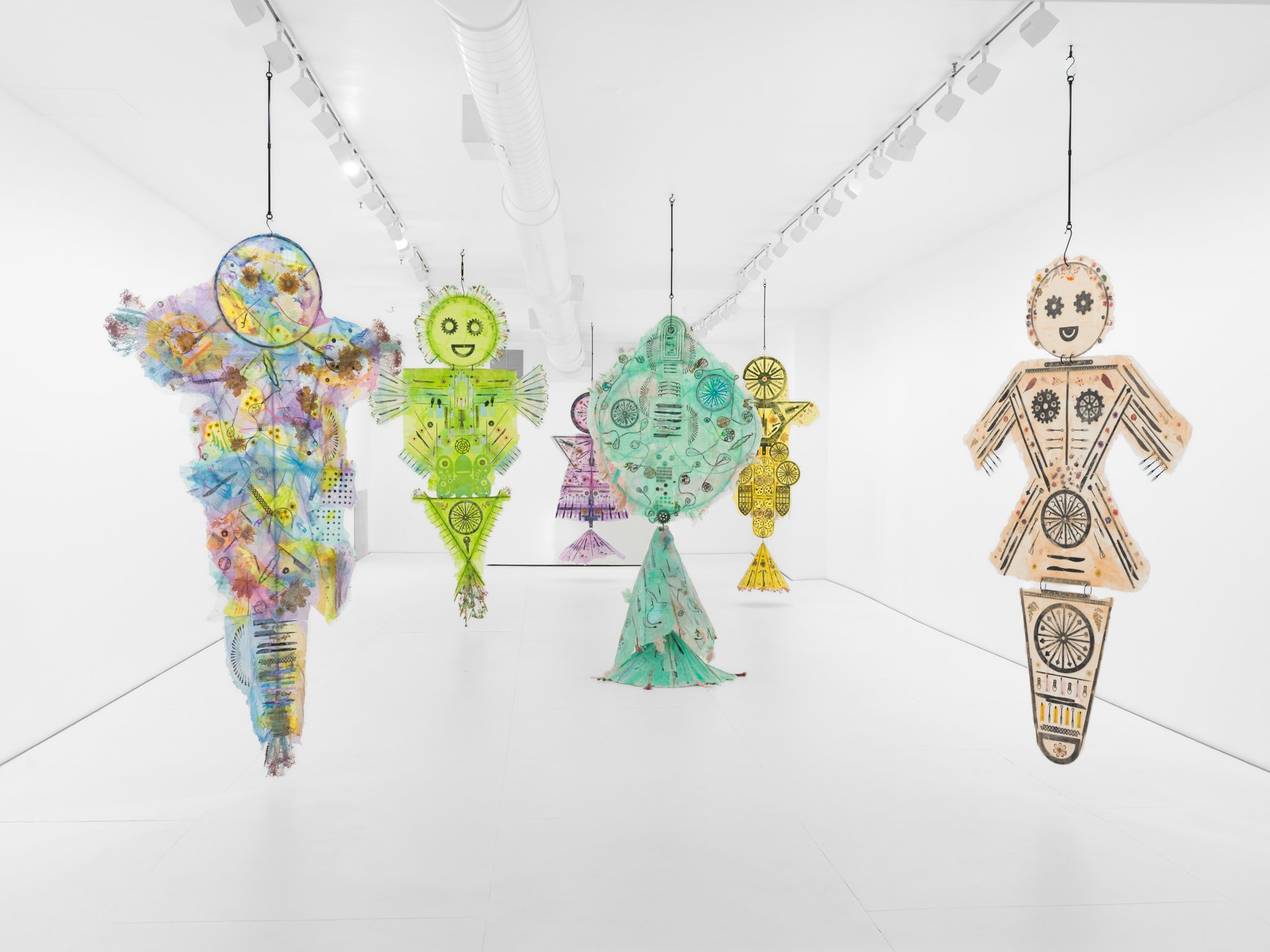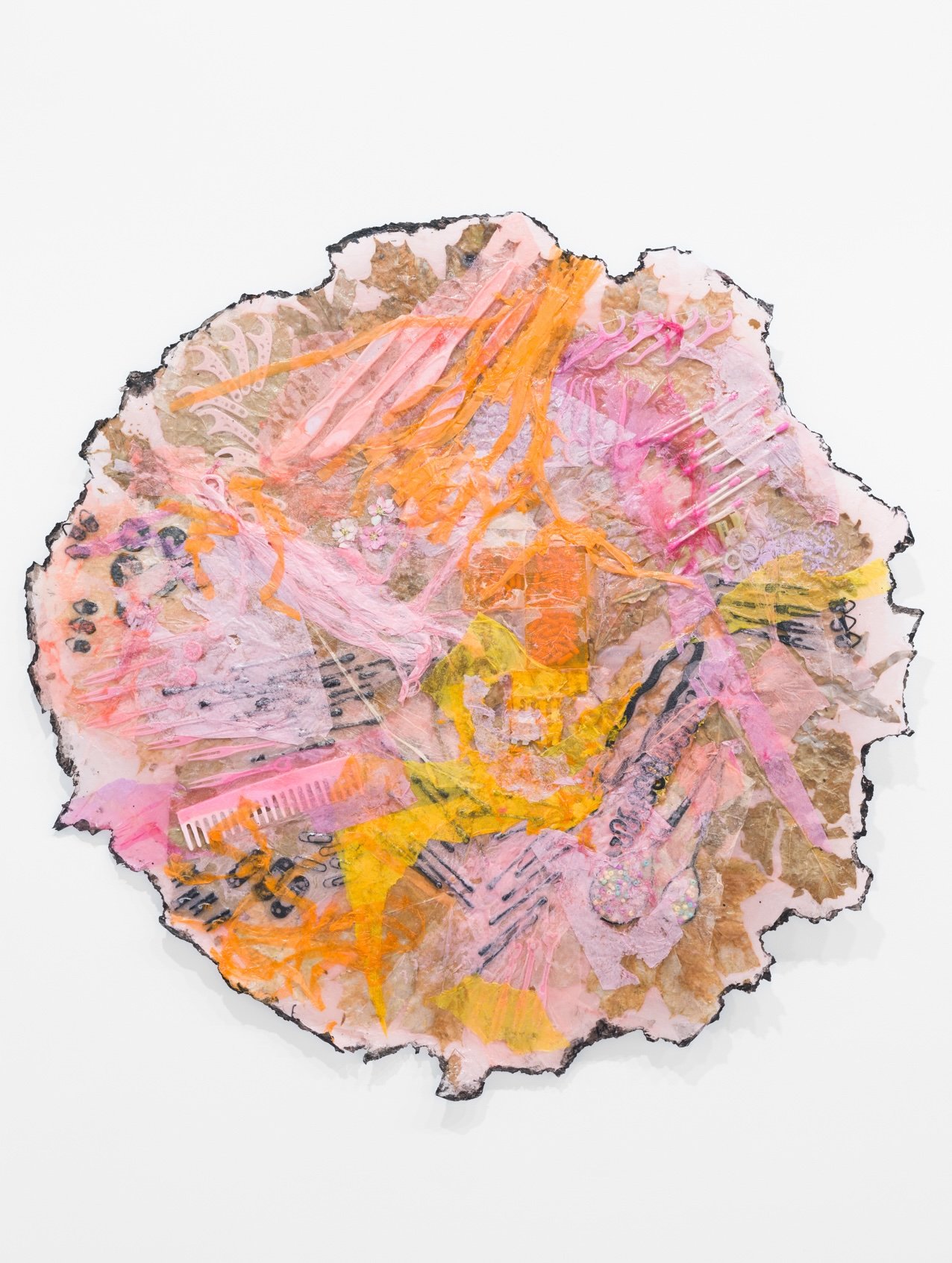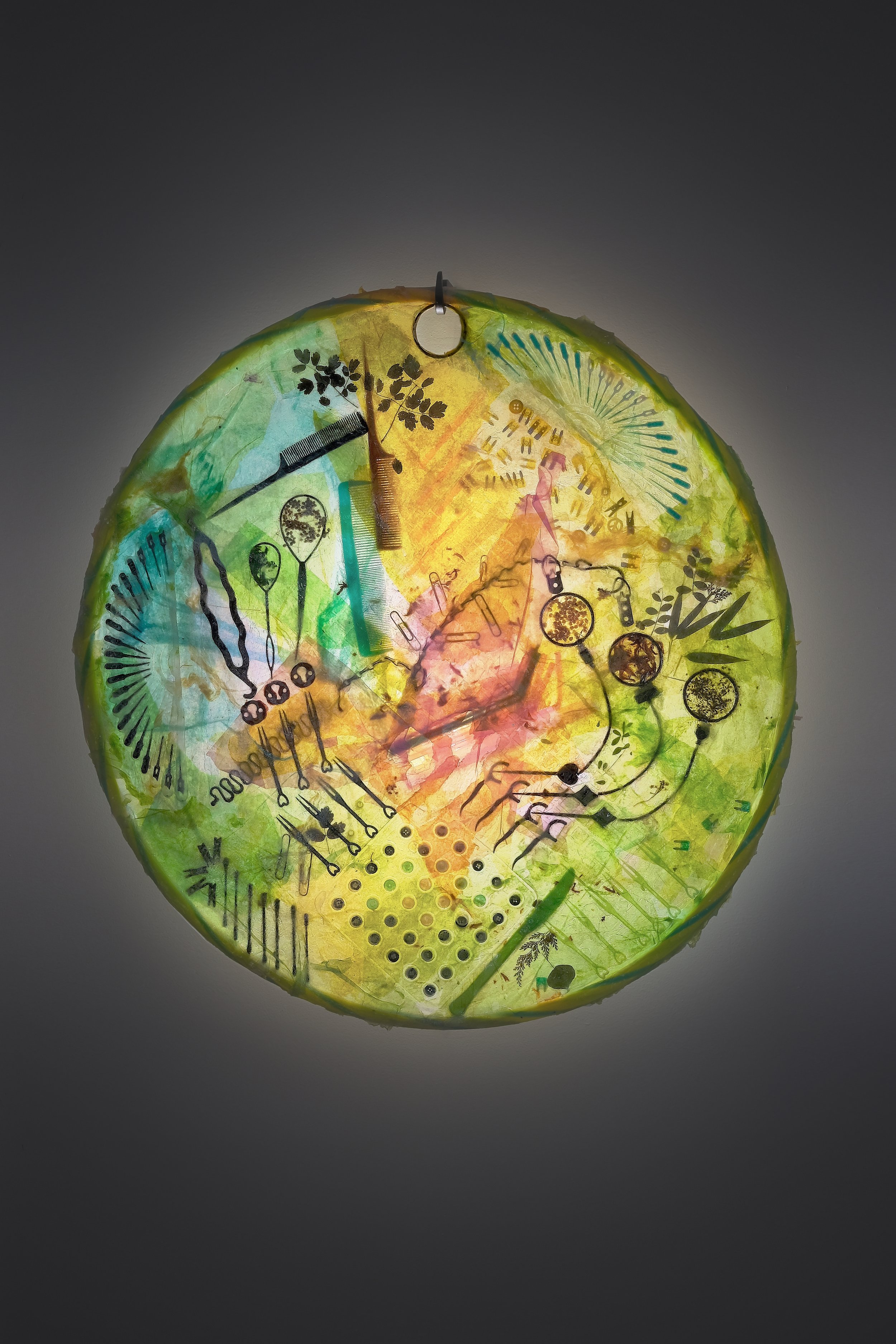Amy Brener
Servers
January 12th – February 17th, 2024
Some reside in subterranean fortresses, some are merchants with commodities to shine. There must be servers to provide, to cradle, shape-soothe-delight: maybe conduits, maybe gods. Serving the minuscule, serving the mighty, unwinding us. They trade with the infinite.
-
Entering the exhibition the viewer is met by large-scale hanging works, rendered in a variety of translucent hues: candy colors, ethereal pastels, earthen melange. Upon first glance, these objects resemble tapestries, kites and giant paper dolls. Each work possesses a distinct character and orbits its own compact universe. Their forms range from overtly figurative, to semi-architectural, to organic amorphism. Up close, each server has its own internal logic; objects are obsessively ordered in some and gesturally scattered across others. Both methods of placement lead to encrusted surfaces of Brener’s signature disposable knick-knacks: flossers, q-tips, straws, plastic cutlery, paper clips, junk electronics and other dollar-store miscellany. Dried plants and flowers flank or encircle these objects, as though commemorating them.
Similar to Brener’s previous Flexi-Shield and Omni-Kit series, the works in ‘Servers’ elevate the status of everyday objects within monumental, devotional or otherworldly forms that demand reverence. While those previous series were composed of futuristic looking resins and silicones, the works in Servers are built using the humbler means of colored tissue paper layered with glue. The paper evokes a plethora of references, from gift wrap, scrapbooks, and kids’ crafts to lanterns, currency, and ancient papyrus.
The tallest among the works, Flapper, grazes the floor and ceiling. It greets viewers with a large circular face, made up of a protractor smile and gearwork eyes. Plastic spoons, forks and q-tips emerge from little pockets on its vest as offerings to the public. The sculpture’s tail resembles a broom made of flowers, as though this big friend is ready to lend a helping foot to sweep up any mess. Another work, Marion, is also blessed with a welcoming “happy to serve you” face. With cocktail-fork fingers and a base that resembles a flattened spinning top, this sculpture recalls 1950s robot dreams. But far from those visions of clunky aluminum, Marion is composed of delicate peach paper strata. Instead of blinking lights, wires and fuses, Marion’s internal network is a skeleton of utensils, hardware and flowers. She understands your gaze and stands ready to help.
While some of the works lean toward monochromy, Freesia demonstrates the ability of layered tissue paper to act as paint, creating complex color relationships and translucencies. Patches of periwinkle, lilac, pink, sunshine yellow and lime recede and emerge around autumn leaves, combs, USB cords, buttons and other doodads. Color is further experimented with in wall works that are lit from behind, such as Shard and Whirly Hoop. Illuminated shades clash and meld into kaleidoscopic stews and cosmic puddles. Their contents appear to be suspended in a rainbow memory state or a mashed up portent of environments to come.
The one free-standing work, Station, takes form somewhere between lamp and rocket. As the name implies, it resonates as a grounding device and generator. With walls that resemble a salt crystal lamp, it is the sort of object that might recharge you or warm you, or allow you access to a network––a hub of many kinds. In this way, all of the works in Servers are here to provide. Maybe it just depends on what you require: a utensil for your next meal, a cord to plug in your device, a smiling face to make your morning brighter, or some spirit to help you absorb the churn of the times. They are beings from an indiscernible heritage. Arriving from a plurality of past, present, and future to serve the masses. An amalgamation of what flows through our needs.
Amy Brener, Servers Installation View
Amy Brener, Servers Installation View
Amy Brener, Servers Installation View
Amy Brener, Servers Installation View
Amy Brener, Servers Installation View
Amy Brener, Servers Installation View
Amy Brener, Servers Installation View
Amy Brener, Servers Installation View
Amy Brener, Servers Installation View
Amy Brener, Servers Installation View
Amy Brener, Servers Installation View
Amy Brener, Servers Installation View
Amy Brener, Servers Installation View
Amy Brener, Servers Installation View
Amy Brener, Servers Installation View
Amy Brener, Servers Installation View
Amy Brener, Servers Installation View, Lower Level Gallery
Amy Brener, Servers Installation View, Lower Level Gallery
Amy Brener, Servers Installation View, Lower Level Gallery
Amy Brener, Servers Installation View, Lower Level Gallery
Amy Brener, Servers Installation View, Lower Level Gallery
Amy Brener, Cyneburg, 2023, Tissue paper, neutral pH PVA, copper, wood, bamboo, miscellaneous objects, yarn, dried flowers and leaves, 87 x 44 x 35 inches
Amy Brener, Cyneburg (Detail)
Amy Brener, Flapper, 2023, Tissue paper, neutral pH PVA, wood, bamboo, miscellaneous objects, dried flowers and leaves, 127 x 62 x 2 inches
Amy Brener, Harvester, 2023, Tissue paper, neutral pH PVA, steel, wood, bamboo, miscellaneous objects, dried flowers and leaves, 98 x 45 x 22 inches
Amy Brener, Harvester (Detail)
Amy Brener, Freesia, 2023, Tissue paper, neutral pH PVA, steel, wood, bamboo, miscellaneous objects, dried flowers and leaves, 80 x 58 x 2 inches
Amy Brener, Freesia (Detail)
Amy Brener, Petunia, 2023, Tissue paper, neutral pH PVA, steel, wood, bamboo, miscellaneous objects, dried flowers and leaves, 85 x 42 x 35 inches
Amy Brener, Petunia (Detail)
Amy Brener, Marion, 2023, Tissue paper, neutral pH PVA, steel, bamboo, miscellaneous objects, dried flowers and leaves, 87 x 48 x 2 inches
Amy Brener, Marion (Detail)
Amy Brener, Platter, 2023, Tissue paper, neutral pH PVA, acrylic medium, ink, wood, bamboo, miscellaneous objects, dried flowers and leaves, 29 x 29 inches
Amy Brener, Station, 2023, Tissue paper, neutral pH PVA, acrylic medium, steel, wood, bamboo, miscellaneous objects, yarn, dried flowers and leaves, 84 x 33 x 33 in
Amy Brener, Station (Detail)
Amy Brener, Simmer Hoop, 2023, Tissue paper, neutral pH PVA, acrylic medium, plastic, miscellaneous objects, dried flowers and leaves, LED light, 30 x 30 inches
Amy Brener, Simmer Hoop, detail
Amy Brener, Whirly Hoop, 2023, Tissue paper, neutral pH PVA, acrylic medium, copper, miscellaneous objects, dried flowers and leaves, LED light, 40 x 40 inches
Amy Brener, Whirly Hoop (Detail)
Amy Brener, Shard, 2023, Tissue paper, neutral pH PVA, acrylic medium, wood, miscellaneous objects, yarn dried flowers and leaves, 50 x 50 inches
Amy Brener, Shard (Detail)





















































